

HTML5 vs Native Android App. Responsive HTML5 Apps: Write Once, Run Anywhere? Where is Anywhere? At the HTML5 DevCon in San Francisco, the enthusiasm toward HTML5 as a development platform was both fantastic and daunting.
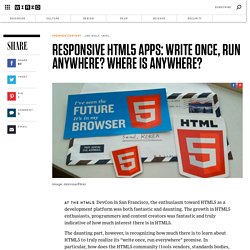
The growth in HTML5 enthusiasts, programmers and content creators was fantastic and truly indicative of how much interest there is in HTML5. The daunting part, however, is recognizing how much there is to learn about HTML5 to truly realize its “write once, run everywhere” promise. In particular, how does the HTML5 community (tools vendors, standards bodies, experienced developers) help these new HTML5 app developers have a great experience and make it equal to, if not better, than native application development experiences?
Here are some thoughts about it. First, let’s define HTML5 and native apps. Web apps – Apps that use only HTML5 code (HTML, CSS, and Javascript) and no native device features or APIs. The biggest problem with native apps is making them available on many different platforms. Responsive design. Now, the only question is: where is anywhere? HTML5 apps can be just as speedy as native apps with the new Famo.us Javascript framework. Get ready for round two of the HTML5-versus-native app debate.
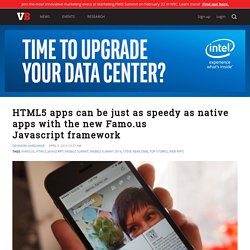
After three years of development, Famo.us is today officially launching a public beta test of its Javascript framework, which lets developers create HTML5-powered mobile apps that are just as fast and fluid as native apps. While the Famo.us pitch may just sound like marketing spin, the company has released a few demos showing off the potential of its framework. Below, check out a demo of Facebook’s Paper app remade with Famo.us, built by a new employee at the company in just a few days: After Facebook and LinkedIn famously postponed their ambitious HTML5 app plans, it seemed as if most developers were ready to give up on HTML5 apps altogether.
Famo.us founder Steve Newcomb was one of those HTML5 doubters. [VentureBeat will be exploring the biggest growth opportunities in mobile at our Mobile Summit next week, including the role of HTML5. “People who understand JavaScript adopt [Famo.us] within twenty minutes,” Newcomb says. HTML5 apps can be just as speedy as native apps with the new Famo.us Javascript framework. HTML5 Developer Job Description Template. HTML5 is the latest and most well adopted standard of HyperText Markup Language.
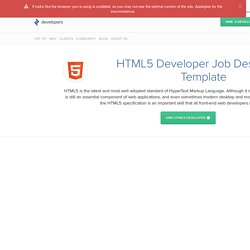
Although it is not a programming language, it is still an essential component of web applications, and even sometimes modern desktop and mobile applications. Familiarity with the HTML5 specification is an important skill that all front-end developers must possess. However, specialization in HTML5 and strong knowledge of its specification is not always sufficient. Therefore, in an HTML5 developer job ad, it is important to include some requirements that are relevant to HTML5 often found in expert front-end developers. This article will provide you with a sample HTML5 developer job description that will help you write a perfect job ad, and assure that you find and hire the person that matches your specific criteria.
Copy this template, and modify it as your own: Company Introduction. 21 - Frontend Developer. Create Games with Construct 2. Modern.
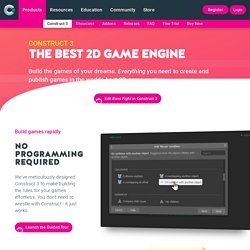
Highly capable. Versatile. This is the all-in-one tool to build and ship your games globally. Simple And Powerful Blocks Construct's unique block-based approach is a simple and exciting way to start designing games. When a mouse touches a cheese increment its health and remove cheese from play area Mouse On collision with Cheese Cheese Mouse Cheese Audio It's both the easiest and most powerful alternative to code. Node or flowchart based tools can quickly land you in a spaghetti-like mess. Learn To Code Programming is a valuable skill, and Construct makes it uniquely easy to learn. Want to go further? And So Much More There are genuinely too many features in Construct to reasonably list here. Ready to get Going? You've found the right tool — Now start making games! Impact - HTML5 Canvas & JavaScript Game Engine. Getting Started With HTML5 Game Development.
There are plenty of valid ways to create an HTML5 game, and quite a bit of material on the technical aspect of each, so for this article I’ll be giving more of a broad overview of HTML5 game development.
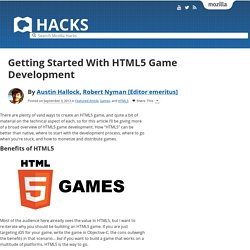
How “HTML5” can be better than native, where to start with the development process, where to go when you’re stuck, and how to monetize and distribute games. Most of the audience here already sees the value in HTML5, but I want to re-iterate why you should be building an HTML5 game. If you are just targeting iOS for your game, write the game in Objective-C, the cons outweigh the benefits in that scenario… but if you want to build a game that works on a multitude of platforms, HTML5 is the way to go. Cross-Platform One of the more obvious advantages of HTML5 for games is that the games will work on any modern device. Unique Distribution. Learn HTML5 - Game Development Course Online. When does the course begin?

This class is self paced. You can begin whenever you like and then follow your own pace. It’s a good idea to set goals for yourself to make sure you stick with the course. How long will the course be available? This class will always be available! How do I know if this course is for me? Take a look at the “Class Summary,” “What Should I Know,” and “What Will I Learn” sections above. Can I skip individual videos? Yes! How much does this cost? It’s completely free! What are the rules on collaboration? Collaboration is a great way to learn. Why are there so many questions? Udacity classes are a little different from traditional courses. What should I do while I’m watching the videos?
Learn actively!